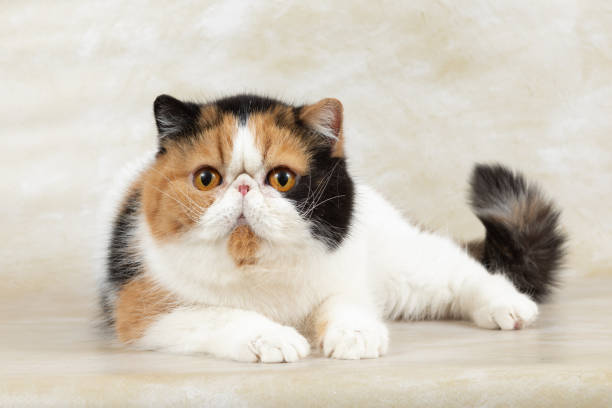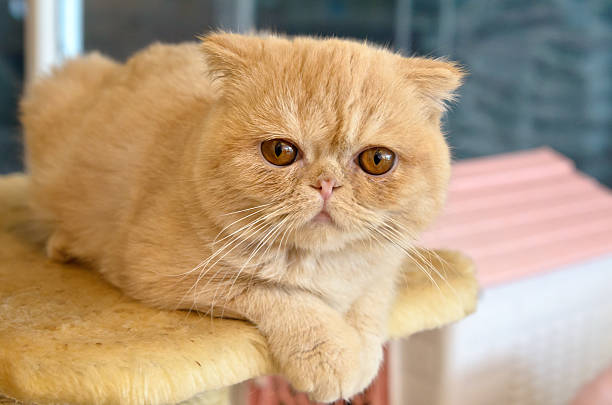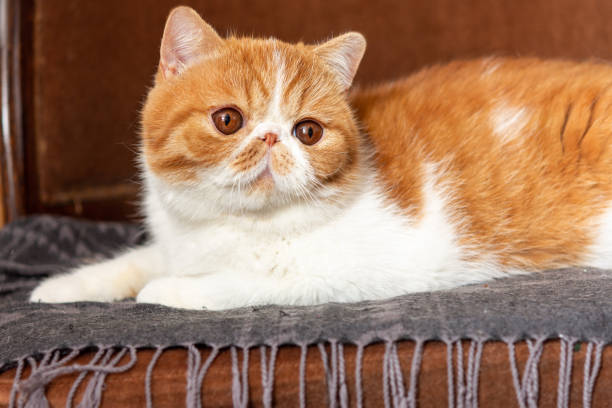Exotic Shorthair

History:
The Exotic Shorthair was developed in the United States during the 1950s as breeders aimed to create a short-haired version of the Persian cat. By crossing Persians with American Shorthairs, Russian Blues, and Burmese, they retained the Persian’s distinctive facial structure and temperament while introducing a dense, plush short coat. The breed was officially recognised by the Cat Fanciers’ Association (CFA) in 1967. Sometimes affectionately called the “lazy man’s Persian,” the Exotic Shorthair combines the luxurious look of the Persian with easier grooming. Their sweet demeanour and teddy bear-like appearance have made them one of the most popular cat breeds worldwide.
Size: Medium to large
Height: 25–30 cm
Weight: 3.5–6.5 kg
Life Expectancy: 12 to 15 years

Breed Appearance:
The Exotic Shorthair has a round, sturdy body with a broad chest, short legs, and a thick neck. Its large, rounded head features a flat face with a short nose, full cheeks, and small, rounded ears set low on the skull. The eyes are large, round, and expressive, coming in a variety of colours that often match the coat. Their defining feature is their dense, plush coat, which is short but soft and stands away from the body due to its thick undercoat. Exotic Shorthairs come in a wide range of colours and patterns, including solid, tabby, bicolour, and colourpoint. Their overall appearance is one of compactness, softness, and gentle charm.
Health & Care:
Exotic Shorthairs are prone to some of the same health concerns as Persians due to their brachycephalic (flat-faced) structure. Common issues include breathing difficulties, tear duct overflow, and dental malocclusions. They may also be susceptible to polycystic kidney disease (PKD), so reputable breeders screen for this condition. Despite these potential issues, with proper veterinary care, they can live long and healthy lives. Their short, thick coat requires regular brushing—ideally two to three times per week—to prevent shedding buildup. Regular eye cleaning, dental hygiene, and ear checks are especially important in maintaining their overall health.

Living Conditions:
Exotic Shorthairs adapt well to a variety of home environments, from small apartments to large houses. They are calm, affectionate, and gentle cats that enjoy lounging and spending time near their owners. While not overly demanding, they do enjoy companionship and prefer not to be left alone for long periods. They are typically quiet, using soft meows and expressive eyes to communicate. Their playful yet laid-back nature makes them ideal for indoor living. They appreciate cosy spots, window views, and moderate play sessions but are not as high-energy as some other breeds.
Grooming:
Though they have short hair, Exotic Shorthairs require more grooming than typical shorthaired breeds due to their thick double coat. Brushing several times a week helps remove loose hairs and prevent shedding-related issues. Their flat faces require regular cleaning to manage tear stains and avoid buildup around the eyes. Routine care should include nail trimming, ear cleaning, and dental maintenance. With consistent grooming and a clean indoor environment, Exotic Shorthairs maintain a tidy, plush appearance and overall good hygiene with relatively moderate effort.

Advantages:
-
Exotic Shorthairs have a sweet, affectionate temperament and often follow their humans around, forming strong, loyal bonds.
-
Their plush, teddy bear-like appearance and expressive faces give them a charming, endearing look that appeals to many cat lovers.
-
They are quiet and gentle, making them ideal for calm households, including those with respectful children or seniors.
-
Exotics are typically less demanding than many breeds and enjoy lounging, making them suitable for people seeking a relaxed companion.
-
They adapt well to indoor living and are content in smaller spaces, requiring only moderate play and stimulation.
Disadvantages:
-
Their flat faces make them prone to respiratory issues, tear staining, and dental problems, requiring attentive care and regular vet checkups.
-
Though short-haired, their dense coat sheds more than expected and needs regular brushing to prevent hair accumulation.
-
They may become anxious if left alone for extended periods, as they form strong bonds and enjoy companionship.
-
Limited physical agility and low activity levels mean they can be prone to weight gain without portion control and regular play.
-
They are not as readily available as some more common breeds, and reputable breeders may charge a premium for healthy, well-bred kittens.

